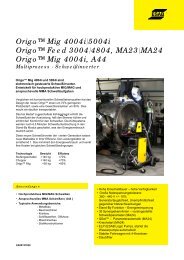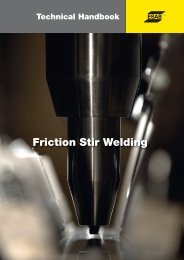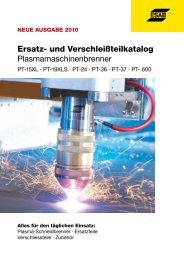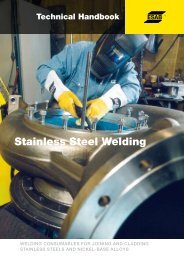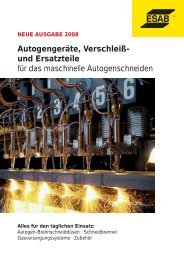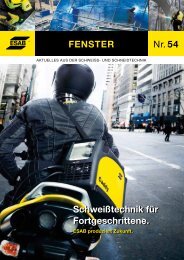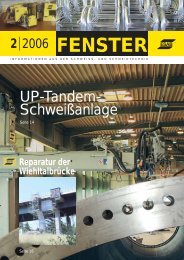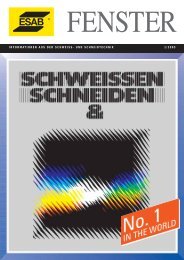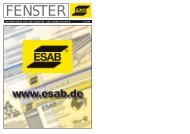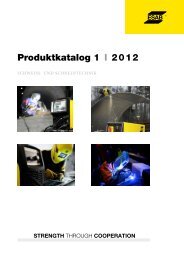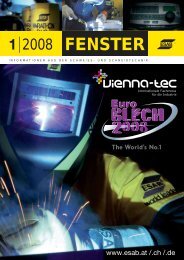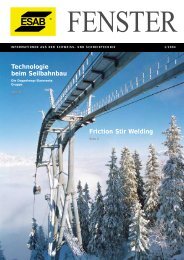Submerged Arc Welding Technical Handbook - Esab
Submerged Arc Welding Technical Handbook - Esab
Submerged Arc Welding Technical Handbook - Esab
You also want an ePaper? Increase the reach of your titles
YUMPU automatically turns print PDFs into web optimized ePapers that Google loves.
Agglomerated and fused fluxes<br />
Agglomerated flux<br />
The main task of SAW fluxes is to<br />
protect the arc, the molten pool and the<br />
solidifying weld metal from the atmosphere.<br />
Moreover fluxes have the following tasks:<br />
<br />
<br />
<br />
<br />
<br />
<br />
<br />
Fluxes consist of minerals such as<br />
quartz, limestone, fluorspar, manganese and<br />
aluminum oxides. These components are<br />
obtained from natural sources, globally, and<br />
are well defined and specified. The ESAB<br />
welding fluxes are composed according to<br />
centrally controlled formulations.<br />
Agglomerated fluxes are designed<br />
for a wide range of applications. Also in<br />
countries where, historically, fused fluxes<br />
have been used, more and more customers<br />
are transferring to agglomerated fluxes.<br />
Since these fluxes are hygroscopic, it is<br />
recommended to re-dry the flux, prior to<br />
use, for hydrogen sensitive applications (see<br />
page 87).<br />
Fused fluxes<br />
Fused fluxes are manufactured by<br />
melting all ingredients in an electrical arc<br />
furnace. The fusion temperature is between<br />
1200 and 1400°C. After the pouring of<br />
the melt and solidification, the material is<br />
crushed to grains, which are dried and<br />
sieved. Characteristically, fused flux grains<br />
are chemically homogeneous - the closest<br />
comparison being crushed glass.<br />
Fused flux<br />
Agglomerated fluxes<br />
Agglomerated fluxes are manufactured<br />
by “rolling” the components with addition<br />
of silicates. For this, the raw materials are<br />
milled to small particles. Many of these small<br />
particles form a grain which contains the<br />
correct proportion of each component. The<br />
grains are dried and baked at temperatures<br />
between 600°C and 850°C. Agglomerated<br />
grains are chemically heterogeneous.<br />
Since these fluxes have not reacted<br />
during manufacturing, metallic deoxidants or<br />
alloying elements can be added. This is one<br />
of the major advantages over fused fluxes,<br />
because the weld metal is more efficiently<br />
deoxidised. As a result the toughness<br />
values achieved at sub-zero-temperatures<br />
are higher than those from fused fluxes.<br />
During welding the flux consumption is<br />
lower, because the density is lower. Also<br />
in many applications the bead shape with<br />
agglomerated fluxes is more favorable.<br />
The grain strength of fused fluxes<br />
is higher than agglomerated fluxes.<br />
This can be beneficial when long flux<br />
delivery distances have to be overcome<br />
by pneumatic transport or when the<br />
recommended addition of fresh flux to the<br />
system is not possible. Fused fluxes are<br />
non-hygroscopic by nature and normally do<br />
not need to be re-dried prior to use.<br />
With high currents and low welding<br />
speeds, e.g. in cladding applications,<br />
some fused fluxes perform better than<br />
agglomerated fluxes. Because re-drying<br />
can be avoided, fused fluxes can be a<br />
beneficial alternative to agglomerated ones.<br />
In combination with basic cored wires giving<br />
high toughness values, fused fluxes are even<br />
applied on hydrogen-crack sensitive, offshore<br />
constructions (see page 22).<br />
72



